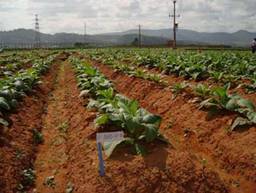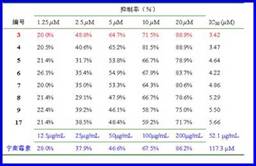Voluminous research facts indicate that most secondary metabolites (Natural Products) of plants are of biological significance, the most representative function of which is ecological effect or chemical defense. Since 2002, Hao Xiao-Jiang’s research group of Kunming Institute of Botany, Chinese Academy of Sciences has been cooperating with Fang Rong-Xiang’s research group of Institute of Microbiology, and Zhang Zhong-Kai’s research group of Yunnan Faculty of Agricultural Sciences of Biotechnology Research Institute for study of natural tobacco mosaic virus (TMV) inhibitors from plants. The results of this collaborative research demonstrate that three different type of anti-TMV agents were discovered from Strobilanthes cusia (Nees) Ktze and Cynanchum paniculatum (Bge.) Kitag., which showed different action mechanisms. Among them, Seco-pregnane sterides are effective and selective inhibitors targeting to subgenomic RNA of alpha-like positive-strand RNA virus (Togaviridae family) including plant-infecting TMV, and animal-infecting Sindbis virus (SINV), eastern equine encephalitis virus and Getah virus,(PNAS,2007(104),8083-8088). New chemical activator AHO induced the systemic acquired resistance in plants via the salicylic acid-mediated signal transduction pathway (Plant Biotechnology Journal, 2008(6), 301-308). Cinchonaglycoside C can induce a ribosome-inactivating protein (RIP), which boasts anti-TMV function (Journal of Integrative Plant Biology, 2007 (49), 1327- 1334). An anti-TMV activity test was conducted on the chemical activator AHO subsidized by important tasks of Chinese Academy of Sciences in the field during 2010. After tobacco's inoculation treatment, the morbidity of tobacco for following three weeks is 4.22%, 33.13% and 35.60% respectively. The tobacco treated with AHO is better than that with other active medicals simultaneously.

AHO field test situation
Benzylphenethylamine Alkaloids isolated from Hosta plantaginea Aschers boasted salient anti-TMV effect, and its representative compound is IC50=1.8 mM of DDN (Journal of Natural Products, 2007(70), 1458-1461).
b-Carboline Compounds isolated from Picrasma quassioides (D. Don) Benn boasted anti-TMV activity. It is worth noting that anti-TMV effect can be intensified when b-Carboline Compound is combined with Nigakilactone B which is lack of anti-TMV activity but isolated from the same plant. It is the first report on anti-TMV of b-Carboline and its synergistic effect against TMV when combined with quassinoid. It indicates that chemical combinations with different methods will probably have chemical defense of plants(Journal of Agricultural and Food Chemistry, 2009 (57), 6590- 6595).

The result of the aetivity of Quassin resistance to TMV
It is discovered that the MeOH extract of the fruit of Brucia javanica (L.) Merr. (Chinese name Ya Danzi) boasted salient anti-TMV activity. By screening-aimed isolation, 17 quassinoids and Glycoside have been isolated. The study results showed that these quassinoids boast anti-TMV activity on different degrees. Eight of them are superior to positive control Lingnanmycin. The strongest one can reach 34 times greater than Lingnanmycin. Further study shows this compound not only inhibits viral infection but also prevent the replication of virus. The study also makes an analysis of structure-activity relationship of anti-TMV activity of quassinois (Journal of Agricultural and Food Chemistry, 2010 (58), 1572- 1577).




